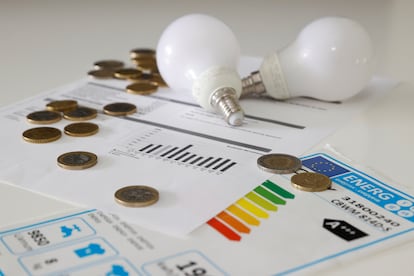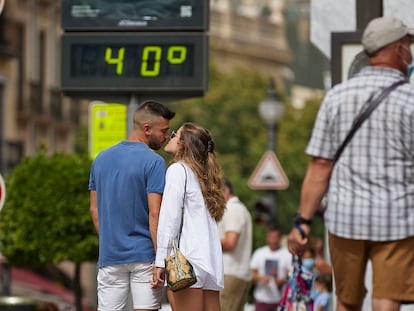Keys to understanding the rising cost of electricity in Spain
EL PAÍS explains why prices on the wholesale market continue to hit record highs and what consumers can do to bring down their bill


The escalation of prices in Spain’s wholesale electricity market, which sets the amount companies supplying households pay, has set five consecutive record highs this week and is having an impact on domestic consumption. On Thursday, the minister for Ecological Transition, Teresa Ribera, admitted there is little the Spanish government can do in the short term. It is external factors that are triggering price hikes that are predicted to continue on an upward trajectory. Here’s a guide to understanding what’s behind the price rises.
1. Why is the cost of electricity going up?
The wholesale market is seeing record high prices. This marks the amount paid by the companies that supply electricity to households and to whom the bill is paid, of which there are around 300 in Spain, although Endesa, Iberdrola and Naturgy have the lion’s share of the market. The price is set by a daily auction. The electricity suppliers bid, specifying what they want to buy and the amount they are willing to pay; and the generators quote how much energy they have for sale and at what price. The Operator of the Iberian Energy Market (Omie) matches them up and the result is an amount that is fixed in time slots over 24 hours the following day. The closing price is the one that is paid to all generating companies, even if they can generate cheaper electricity.
The energy on offer is sourced from renewables and nuclear power plants, coal-fired thermal power plants and combined cycle plants. The latter use fossil fuels and, when these are in demand at any given time, their price increases.
2. Why is producing energy with fossil fuels more expensive?
International gas markets are setting very high prices. The reason for this is that last winter was colder than usual and many countries, including China, ran out of gas. To prepare for the coming winter, they must replenish their reserves and so the price has risen from around €16 per megawatt-hour (MWh) last winter to what is currently over €46. There is also the cost of releasing carbon dioxide (CO2) under the European Union’s emissions trading scheme. This price has also risen this year due to Brussels’ decision to encourage emissions cuts.
3. How long will the prices remain high?
The futures markets, which serve to predict trends, indicate that electricity will remain expensive over a prolonged period of time. If we take the price of gas as an indicator, experts believe that the current situation will continue at least until the first quarter of 2022. Another issue is the prices we have seen this week. The heatwave that is hitting Spain has contributed to these as it boosts demand for air conditioning, while less wind means less wind power is being generated. The result is more electricity produced by burning gas. The current upward trend is likely to come to an end as early as this Saturday, because lower industrial demand on weekends leads to cheaper prices. But if the heat continues, Monday may see a rebound with new highs.
4. How is the wholesale auction price passed onto the household bill?
In Spain, domestic consumers can subscribe to the regulated tariff (the Voluntary Price for Small Consumers or PVPC) or contract electricity on the free market. According to the latest data from the National Commission for Markets and Competition (CNMC), the former account for 10.6 million households and the latter, 16.2 million households.
The regulated tariff is indexed to the wholesale market and therefore, regarding consumption (one of the items paid when contracting the electricity supply), the price of each kilowatt oscillates according to the market. The wholesale market price also has an impact on other items that depend on consumption, for example, sales tax (VAT): it is not the same to pay 10% of something that costs €1 as it is to pay 10% of something that costs €3. It used to be that the part of the bill that depended on consumption did not exceed one third of the total, but in these kinds of circumstances, when the price per kilowatt is rising and other items remain stable, or even fall, such as VAT, consumption accounts for almost half of the total bill.
5. What happens if I am not on the regulated tariff?
Bad news. This will almost certainly affect you in the long run if it isn’t affecting you already. It depends on the type of tariff you have agreed with the supplier. Some work in a similar way to the PVPC and oscillate with market prices. Others have hourly differences, but at fixed prices. But even with tariffs that use a price agreed in advance between the supplier and the customer, the escalation of the wholesale market ends up having an impact. “In the face of significant long-term increases, companies are eventually forced to raise the price,” says energy analyst Ricardo Margalejo, co-founder of Gana Energía.
6. What other costs are on the bill?
In addition to consumption, other regulated costs are paid on the electricity bill, such as those for the transmission and distribution networks (the facilities and power lines that carry the electricity from the places where it is produced to homes, which depend partly on the state-owned multinational Red Eléctrica de España and partly on the electricity companies). There are also fees used for the promotion of renewable energies, and fees to cover tariff deficits and to share out the higher cost of the non-mainland systems. These costs depend on governmental decisions. Part of the bill also depends on the energy potential contracted by each household, rental meter charges and taxes.
7. How can you bring down your bill?
“There are always things that can be done, but the reality is that they are limited,” says Miguel Ángel Serrano, vice-president of the Consumers in Action (Facua) organization. Measures that can help are not leaving electrical appliances on standby, such as the red dot you see on TV, using power strips with switches that allow the current to be completely disconnected, not leaving chargers plugged in and putting on appliances such as irons and washing machines in off-peak hours. “The solution is not for consumers to adapt their habits because their margin is small,” according to the organization. “It is for the institutions, particularly the government, to take measures that will help the consumer.”
English version by Heather Galloway.
Tu suscripción se está usando en otro dispositivo
¿Quieres añadir otro usuario a tu suscripción?
Si continúas leyendo en este dispositivo, no se podrá leer en el otro.
FlechaTu suscripción se está usando en otro dispositivo y solo puedes acceder a EL PAÍS desde un dispositivo a la vez.
Si quieres compartir tu cuenta, cambia tu suscripción a la modalidad Premium, así podrás añadir otro usuario. Cada uno accederá con su propia cuenta de email, lo que os permitirá personalizar vuestra experiencia en EL PAÍS.
¿Tienes una suscripción de empresa? Accede aquí para contratar más cuentas.
En el caso de no saber quién está usando tu cuenta, te recomendamos cambiar tu contraseña aquí.
Si decides continuar compartiendo tu cuenta, este mensaje se mostrará en tu dispositivo y en el de la otra persona que está usando tu cuenta de forma indefinida, afectando a tu experiencia de lectura. Puedes consultar aquí los términos y condiciones de la suscripción digital.
More information
Últimas noticias
Most viewed
- David King, chemist: ‘There are scientists studying how to cool the planet; nobody should stop these experiments from happening’
- Reinhard Genzel, Nobel laureate in physics: ‘One-minute videos will never give you the truth’
- Mexico completes its trade shift with the entry into force of tariffs on China and countries without trade agreements
- Oona Chaplin: ‘I told James Cameron that I was living in a treehouse and starting a permaculture project with a friend’
- Sinaloa Cartel war is taking its toll on Los Chapitos










































